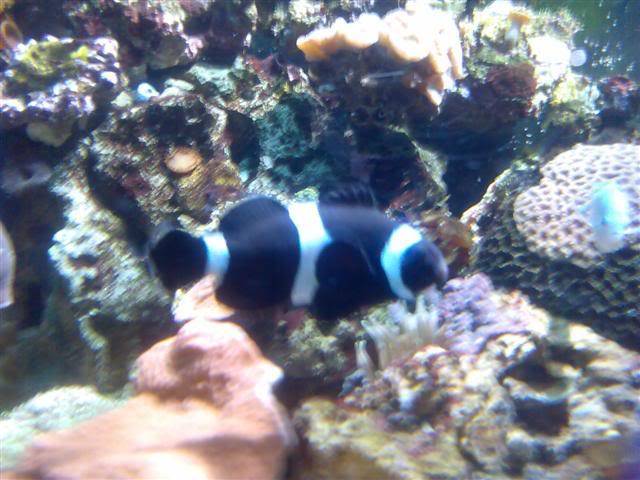marine67

Posts : 95
Join date : 2007-11-17
Location : Winsford, Cheshire
 |  Subject: clowns Subject: clowns  Tue Nov 20, 2007 2:58 am Tue Nov 20, 2007 2:58 am | |
| Here are the other to which live in the same tank trying to see if these two will get it on    Scientific Name: Amphiprion percula Common Names: Percula Clownfish, Percula Anemonefish, Clown Anemonefish, Percula Clownfish, True Percula Clownfish Max. size: 11.0 cm TL (male/unsexed) Environment: reef-associated; non-migratory; marine; depth range 1 - 15 m Distribution: Western Pacific: Queensland and Melanesia including northern Great Barrier Reef, northern New Guinea, New Britain, Solomon Islands and Vanuatu. Not known from New Caledonia and the Fiji Islands, although Fowler (1959) recorded it from the latter area. Often confused with Amphiprion ocellaris. Morphology: Dorsal spines (total): 9-10; Dorsal soft rays (total): 14-17; Anal spines: 2; Anal soft rays: 11-13. Overall orange with three black-bordered vertical white bands. The fins also orange with black edges. Dorsal count of 9 spines. Biology: Inhabits lagoon and seaward reefs. Each group of fish consists of a breeding pair and 0-4 non-breeders. Within each group there is a size-based hierarchy: the female is largest, the male is second largest, and the non-breeders get progressively smaller as the hierarchy is desceded. If the female dies, the male changes sex and becomes the breeding female, while the largest non-breeder becomes the breeding male. The maintenance of size differences may avoid conflicts, because subordinates do not become a threat to their dominants. Appears to occur in shallower depths than A. ocellaris. This species has been reared in captivity. Associated with the anemones: Heteractis crispa, Heteractis magnifica, and Stichodactyla gigantea Aquarium Care: For anemone association, see Biology section above. This species is similar to A. ocellaris (Ocellaris Clownfish), except the white bars on the body are outlined in black. More aggressive towards members of the same species, compared to A. ocellaris. Can be kept singly or in a pair. 2 juveniles will usually grow into a mated pair. Adult females are larger than the male mates (same for A. ocellaris). | |
|
